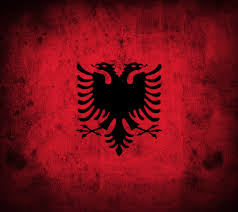I am really fascinated with Albania’s music. And I didn’t realize I was. Among some
of the instruments, one of the early ones was the lahuta, a one-stringed
lute-like instrument. But as they say, one is the loneliest number, and it soon
gave way to a more popular two-stringed version called çiftelia. Probably introduced during the 500 years
of Ottoman rule, the medium sized frame drum with jingles called the dajreja is
used for keeping rhythm. It seems similar to the tambourine, which is also
used.
But one style that struck me is the vocal iso polyphony
heard in the southern regions. If
you listen, it gives the same effect as a bagpipe (which is also used in
Albanian music): you have a drone note and the melody on top. There is a leader, who’ll sing the
introductory phrase and the others will follow. There are several groups who have formed in recent years in
an effort to preserve Albania’s traditional folk music.
Classical music is also on the rise with several prominent
music conservatories focusing on creating Albanian composers and classical
musicians. Opera seems to be one of the fortes (no pun intended), especially
given it’s proximity to Italy. Probably one of the most famous opera singers in
Albania is Inva Mula. She was the voice of the Diva Plavalaguna in the movie The Fifth Element. You know the song -- it's the best part of the movie.
As far as modern music goes, I came across two that
impressed me: Genta Ismajli and Bertan Asllani. I found Genta’s 2011 album Guximi available on iTunes for $9.99.
I’m definitely planning on buying it (although it’s also available to listen to
on Spotify).
I’m not able to find very many songs for Bertan, except a few individual songs on iTunes and a few more on Spotify. But unfortunately I can't find this song and I really like it. I do believe he has a Facebook page and I could probably find info there.
Because of the influence from the Ottomans, mosaic art is
very popular. Mural paintings are also quite popular. Probably one of the most widely
known mosaic artists is Saimir Strati, who have won numerous Guinness World
Records for his work. His work is pretty cool. I’d love to see it up close. Of
course mosaic art is one of my favorite mediums, so I’m a little partial. This particular mosaic is make of cork.
Early Albanian texts were strictly religious works and
historical documents. Pjetër Budi was one of the first to write poetry in
Albanian. Of course Albanian literature went through its eras, just like
English literature does. Ismail Kadare is thought of as one of the best-known
contemporary authors. Fifteen of his novels have been translated into 40
languages, bringing Albanian literature to accessibility in Europe and
throughout the world. There are
many of his books available through Amazon and many of those are also available
for the Kindle – some as low as $3.19! You can’t beat inexpensive literature. Definitely
thinking of making a Kindle purchase in the near future…










